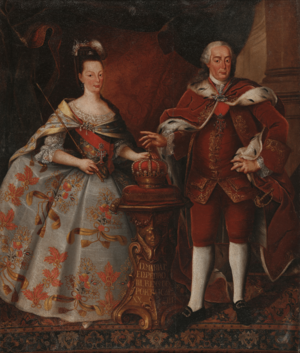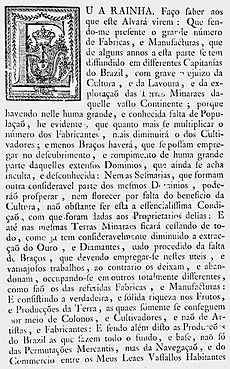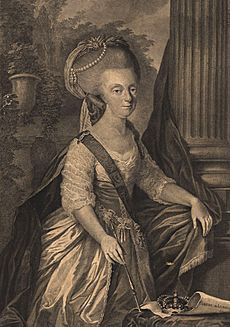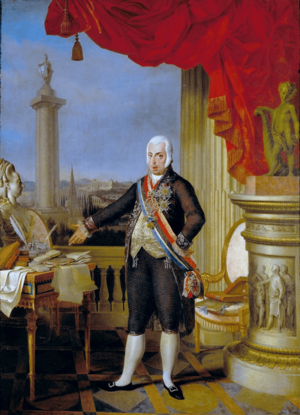Maria I of Portugal facts for kids
Quick facts for kids Maria I |
|||||
|---|---|---|---|---|---|
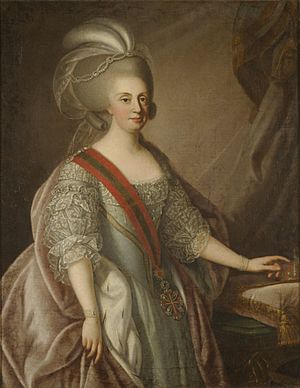
Portrait attributed to Giuseppe Troni, c. 1790–1807
|
|||||
| Queen of Portugal | |||||
| Reign | 24 February 1777 – 20 March 1816 | ||||
| Acclamation | 13 May 1777 | ||||
| Predecessor | Joseph I | ||||
| Successor | John VI | ||||
| Co-monarch | Peter III (1777–1786) | ||||
| Regent | John, Prince Regent (1792–1816) | ||||
| Queen of Brazil | |||||
| Reign | 16 December 1815 – 20 March 1816 | ||||
| Successor | John VI | ||||
| Regent | John, Prince Regent | ||||
| Born | 17 December 1734 Ribeira Palace, Lisbon, Portugal |
||||
| Died | 20 March 1816 (aged 81) Convent of Carmo, Rio de Janeiro, Brazil |
||||
| Burial |
|
||||
| Spouse | |||||
| Issue Detail |
|
||||
|
|||||
| House | Braganza | ||||
| Father | Joseph I of Portugal | ||||
| Mother | Mariana Victoria of Spain | ||||
| Religion | Roman Catholicism | ||||
| Signature |  |
||||
Dona Maria I (born December 17, 1734 – died March 20, 1816) was the Queen of Portugal from 1777 until her death in 1816. In Portugal, she was known as Maria the Pious because of her strong religious beliefs. In Brazil, she was called Maria the Mad due to her mental health struggles later in life.
She was the first queen to rule Portugal on her own. She was also the first ruler of Brazil when it became a kingdom. Maria was the oldest daughter of King Dom José I and Infanta Doña Mariana Victoria of Spain. As the next in line to the throne, she held the titles of Princess of Brazil and Duchess of Braganza.
In 1760, she married her uncle, Infante Dom Pedro. They had six children, but only three lived to be adults: Dom José, Prince of Brazil; King Dom João VI of Portugal; and Infanta Mariana Vitória. When her father, King José, died in 1777, Maria became queen at 42 years old. Her husband, Pedro, became king alongside her, but Maria held the real power.
When Maria became queen, she removed her father's powerful chief minister, the Marquis of Pombal. The early years of Maria's rule saw Portugal's economy grow. She ordered the building and repair of many national buildings. This included finishing the Palace of Queluz and opening the Palace of Ajuda. After her husband died in 1786, and then her eldest son José and her religious advisor died in 1788, the queen began to suffer from a serious illness. Her second son, João, then became the prince regent (ruler in her place).
Because of Napoleon's wars in Europe, Maria and her royal court moved to the Portuguese colony of Brazil in 1807. In 1815, Brazil was made a kingdom, and Maria became Queen of the United Kingdom of Portugal, Brazil and the Algarves. When she died in 1816, her son, Dom João VI, became king.
Contents
Early Life and Family
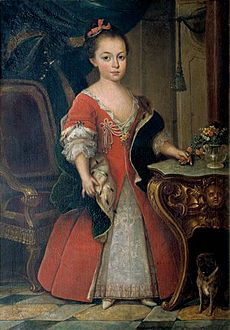
Maria was born at the Ribeira Palace in Lisbon, Portugal. Her full name was Maria Francisca Isabel Josefa Antónia Gertrudes Rita Joana. She was the oldest of four daughters born to Dom José (Joseph), who was then the Prince of Brazil. Her mother was Infanta Mariana Victoria of Spain.
Maria's father, José, was the son of the king at the time, Dom João V of Portugal. Her mother, Mariana Victoria, was the oldest daughter of King Don Felipe V of Spain. On the day Maria was born, her grandfather King João V gave her the title of Princess of Beira.
King João V died on July 31, 1750. Maria's father, Prince José, then became King Dom José I. As José's oldest child, Maria became the next in line to the throne. She was given the traditional titles of Princess of Brazil and Duchess of Braganza.
The Marquis of Pombal's Influence
King José's government was largely controlled by Sebastião José de Carvalho e Melo, the Marquis of Pombal. The king often spent time at the Queluz National Palace, which he later gave to his daughter, Princess Maria, and her husband, Infante Pedro. The Marquis of Pombal gained even more power after the terrible 1755 Lisbon earthquake, which killed about 100,000 people. The palace where Maria was born was also destroyed in this disaster.
After the earthquake, King José felt uncomfortable in closed spaces. He had a new palace built in Ajuda, away from the city center. This palace was called Real Barraca de Ajuda (Royal Hut at Ajuda) because it was made of wood. The royal family spent a lot of time there. Maria's first child, José, was born in this palace. In 1794, the wooden palace burned down, and the Palace of Ajuda was built in its place.
On June 6, 1760, Maria married her uncle, Pedro. He later became King Dom Pedro III of Portugal. Maria and Pedro had six children: José, João Francisco, João (who later became King Dom João VI), Mariana Vitória, Maria Clementina, and Maria Isabel. Only José, João, and Mariana Vitória lived to be adults. Maria also had a baby who was stillborn in 1762.
Maria's Reign as Queen
King José died on February 24, 1777. His daughter, Maria, then became the first queen to rule Portugal on her own. When Maria became queen, her husband became King Dom Pedro III. However, Maria held all the real power because she was the direct heir to the crown. Pedro's title as king came only from being married to Maria. If Maria had died before him, the crown would have passed to her children, not to him. Pedro died before Maria, in 1786.
Maria was seen as a good ruler before her illness began. Her first important act as queen was to remove the powerful secretary of state, the Marquis of Pombal. He had reduced the power of the noble families. During her early reign, Portugal joined the First League of Armed Neutrality in 1782. Also, in 1781, Delagoa Bay was given from Austria to Portugal.
On January 5, 1785, Queen Maria issued a rule that limited industrial activities in Brazil. For example, it stopped the making of most fabrics and other goods. This was because the Portuguese government did not want Brazil to develop its own industries. They feared Brazil might become too economically independent, which could lead to political independence. During her reign, a famous event was the trial and execution of Joaquim José da Silva Xavier, known as Tiradentes, in 1789.
Maria's Mental Health Struggles
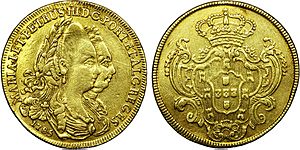
Maria's mental health problems were first officially noticed in 1786. She had to be carried back to her rooms in a state of confusion. After this, the queen's mental state became worse. On May 25, 1786, her husband died. Maria was very sad and stopped all court entertainment. People said that royal parties started to look like religious ceremonies.
Her oldest son and heir, Prince Dom José, died at age 27 from smallpox on September 11, 1788. Her religious advisor also died in November of that year. These losses may have caused Queen Maria to develop a serious illness. Some historians also think her family history might have played a role, as two of her sisters had similar conditions.
By February 1792, Maria was considered unable to rule. She was treated by Francis Willis, the same doctor who treated the British king George III. Willis suggested taking her to England, but the Portuguese court did not agree. Maria's second son, Dom João (John), who was now the Prince of Brazil, began to govern in her name. He officially became Prince Regent in 1799. When the wooden Real Barraca de Ajuda palace burned down in 1794, the court moved to Queluz. The ill queen would stay in her rooms all day, and visitors sometimes heard loud screams coming from her apartments.
The Napoleonic Wars and Moving to Brazil
In 1801, the Spanish Prime Minister Manuel de Godoy sent an army to invade Portugal. This was supported by the French leader Napoleon. This led to the War of the Oranges. Although Spain ended its invasion, the Treaty of Badajoz on June 6, 1801, forced Portugal to give up Olivença and other border towns to Spain. On September 29, 1801, Prince Dom João signed the Treaty of Madrid (1801), giving half of Portuguese Guyana to France. This area became French Guiana.
Portugal refused to join Napoleon's plan to stop trade with Britain, called the Continental Blockade. This led to a French and Spanish invasion of Portugal in late 1807, led by General Jean-Andoche Junot. Napoleon's plan was to divide Portugal into three parts.
The Royal Family Moves to Brazil
The British government urged the entire House of Braganza (the royal family) to leave Portugal. On November 29, 1807, they decided to move to the Portuguese colony of Brazil to set up a government there. Maria, along with the rest of the royal family, traveled on a large ship called the Príncipe Real. During her journey from the palace to the docks, she was heard screaming. Her illness was so severe that she feared her servants would harm her.
In January 1808, Prince Regent João and his court arrived in Salvador da Bahia, Brazil. Local leaders and the British government pressured the prince regent to sign a new trade rule. This rule opened trade between Brazil and friendly nations, which mainly helped Great Britain. This change broke an old rule that had only allowed Brazil to trade directly with Portugal.
On August 1, 1808, British General Arthur Wellesley (who later became the Duke of Wellington) landed a British army in Lisbon. This marked the start of the Peninsular War. Wellesley's first victory against Junot at the Battle of Vimeiro (August 21, 1808) was important. However, a later agreement, the Convention of Cintra (August 30, 1808), allowed the defeated French troops to leave Portugal peacefully.
Wellesley returned to Portugal on April 22, 1809, to continue the fight. Portuguese soldiers, fighting alongside the British, showed great bravery in defending the Lines of Torres Vedras (1809–1810). They also helped in the later invasions of Spain and France. In 1815, Prince João's government made Brazil a kingdom. Maria was then declared Queen of the United Kingdom of Portugal, Brazil and the Algarves. Even after Napoleon was defeated in 1815, Maria and her family stayed in Brazil.
Death and Legacy
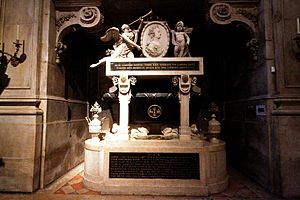
Maria lived in Brazil for eight years, always in a state of illness. In 1816, she died at the Carmo Convent in Rio de Janeiro at the age of 81. After her death, the prince regent became King Dom João VI. In 1821, Maria's body was returned to Lisbon. She was buried in a special tomb at the Estrela Basilica (Portuguese: Basílica da Estrela), a church she had helped build.
Maria is a respected figure in both Brazil and Portugal. Many important changes happened during her reign. In Portugal, she is seen as a strong female leader. Her legacy is clear at Portugal's Queluz Palace, a beautiful building she helped design. A large statue of her stands in front of the palace, and a hotel nearby is named in her honor. A large marble statue of the queen was also placed at the Portuguese National Library in Lisbon.
In Brazil, Maria is important because she played a key role in Brazil eventually becoming independent. During her reign, even though her son was ruling for her, many national organizations and institutions were created in Brazil. These were the beginnings of modern Brazilian institutions and gave more power to the people living in the colony. While she is often called A Louca (the Mad) in Brazil, historians in both Brazil and Portugal think highly of her.
Marriage and Children
Maria married her uncle Pedro on June 6, 1760. At the time, Maria was 25 and Pedro was 42. Despite the age difference, they had a happy marriage. When Maria became queen in 1777, her husband became the King Dom Pedro III of Portugal.
| Name | Birth | Death | Notes |
|---|---|---|---|
| Joseph, Prince of Brazil | 20 August 1761 | 11 September 1788 | José Francisco Xavier de Paula Domingos António Agostinho Anastácio married his mother's sister, Infanta Benedita of Portugal, but they had no children. His death meant his younger brother became the next in line to the throne and later king. |
| John of Braganza | 20 October 1762 | 20 October 1762 | João was a baby who was stillborn (born without signs of life) at the Ajuda National Palace. |
| John Francis of Braganza | 16 September 1763 | 10 October 1763 | João Francisco de Paula Domingos António Carlos Cipriano was born at the Ajuda National Palace. |
| John VI | 13 May 1767 | 10 March 1826 | João Maria José Francisco Xavier de Paula Luís António Domingos Rafael married Carlota Joaquina, the oldest daughter of King Don Carlos IV of Spain, and they had children. He was King of Portugal from 1816 to 1826 as Dom João VI. |
| Infanta Mariana Victoria of Portugal | 15 December 1768 | 2 November 1788 | Mariana Vitória Josefa Francisca Xavier de Paula Antonieta Joana Domingas Gabriela married Infante Gabriel of Spain, son of King Don Carlos III, and they had children. |
| Maria Clementina of Braganza | 9 June 1774 | 27 June 1776 | Maria Clementina Francisca Xavier de Paula Ana Josefa Antónia Domingas Feliciana Joana Michaela Julia de Bragança was born at the Queluz National Palace. |
| Maria Isabella of Braganza | 12 December 1776 | 14 January 1777 | Maria Isabel was born at the Queluz National Palace. |
See also
 In Spanish: María I de Portugal para niños
In Spanish: María I de Portugal para niños



